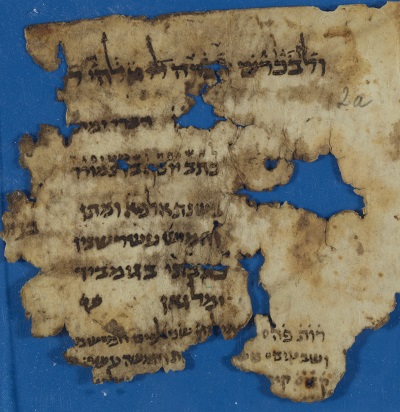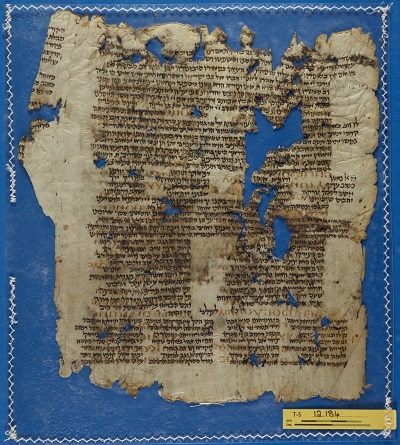The oldest Hebrew fragment in the Collection? T-S NS 3.21
According to the introduction in Davis and Outhwaite, Hebrew Bible Manuscripts in the Cambridge Genizah Collections, vol. iv, there are 24,326 separately-catalogued pieces of Hebrew Bible in the Taylor-Schechter and Westminster College Genizah Collections. What makes this one, a piece of Torah scroll from the New Series of the T-S Collection, so special then? Well, it may be the oldest Hebrew fragment in the Collection.
Of course, as a Torah scroll it is not dated, and therefore declaring it the oldest fragment requires some qualification.
The oldest dated Hebrew fragment in the Collection is from the beginning of the tenth century, and is also biblical. It's T-S NS 324.26.2, two leaves from a small codex containing the end of the book of Nehemiah, followed by a colophon. The colophon, written by a certain יוסף בן נמורד, Joseph ben Nimored, states that the book was finished in 1215 in Gunbad-i-Mallgan (modern Dū Gunbadān in Iran). Although Joseph does not identify the system of dating that he was using, it is most likely to be that of לשטרות (lišṭarot, ‘documents’), i.e., the Era of Documents, which dates from the establishment of the Seleucid Empire in 312 BCE. 1215 equates to 903–904 CE (allowing for the difference between the calendars).
The colophon of T-S NS 246.26.2, the oldest dated Hebrew manuscript in the Collection
This is the oldest dated fragment, but there are many more manuscripts in the T-S Collection that are undoubtedly more ancient than this one. Probably our oldest fragments are the Greek palimpsests, some of which have been dated on palaeographic grounds to the 5th or 6th centuries. While these manuscripts also have Hebrew text on them, the upper script is much later, probably no earlier than the 9th or 10th c.
One of the oldest of the palimpsests in the Collection, Aquila's Greek translation of the Bible, with liturgical poetry by Yannai written over it.
This has been assigned palaeographically to the 6th c. CE, making it four or five hundred years older than the Genizah chamber in which it was discovered. The study of Greek palaeography is advanced, thanks to the wealth of manuscripts available, and this dating seems convincing. It is another matter, however, when we turn to the earliest Hebrew manuscripts in the Collection.
It is perhaps not surprising that the earliest items to be found in the Collection are Bibles, if we assume that the original principles of genizah were to store only 'holy books', rather than the other literary works and documents that come to be deposited in large numbers in the 10th–13th centuries. But dating Bibles, particularly Torah scrolls, is tremendously difficult; such stringent rules and customs govern their production that different scrolls may show only very slight variations in style and script over the centuries.
It is in the slight variation, however, that the distinction between an early and a later manuscript can often be discerned. The palaeographers Ada Yardeni and Colette Sirat both found themselves drawn to T-S NS 3.21, a large piece of a biblical scroll, because of the unusual nature of its script and the slight differences between the text and that of the standard masoretic tradition. The scroll, of which two parts have been found in the T-S Collection, T-S NS 3.21 and a small piece T-S NS 4.3, contains only the book of Genesis, so it may have been a Genesis scroll rather than the whole Torah. Colette Sirat estimated that if it had contained the whole Torah, then it would have measured 40m long. The script is highly distinctive, when compared with that of most Bible fragments in the Collection, with an acutely-angled serif and what Ada Yardeni believes are some of the earliest regular examples of tagin, the ornamental 'crowns' that appear only in Torah scrolls (with a few exceptions). The hand is similar to that of the (very few) Hebrew and Aramaic papyri of the Byzantine period (300–700 CE).

Detail (Genesis 14:12-13) showing the distinctive serifs of the letters
Sirat also detects differences from the Masoretic Text (MT) in the division of paragraphs (paraša petuḥa and paraša setuma), though these are minor, and one consonantal difference from the MT at Genesis 17:1, where the scroll has שנה for the MT's plural שנים.

Genesis 17:1, showing the singular where MT has the plural
According to Sirat, the scroll is early, pre-Islamic, and dates from the fifth or sixth century. Although this is centuries earlier than the great majority of Genizah fragments, it would make it contemporaneous with some of the underscripts of the palimpsests in the Collection and its survival in the Genizah is therefore not at all impossible. Nothing is straightforward in dealing with undated manuscripts, however, and Ada Yardeni prefers to date it later, to the eighth or ninth century, still early, but not as spectacularly so. There appear to be sufficient grounds, however, to believe that an earlier dating is more likely, given the clear differences in hand, in particular, from most other Bible manuscripts found in the Genizah, and it is thrilling to think that this scroll may have been in use in synagogue services hundreds of years before being consigned to the Ben Ezra Genizah.
T-S NS 3.21, the Genesis scroll
Bibliography
Michelle P. Brown (ed.), In the beginning; bibles before the year 1000 (Washington DC, 2006).
Colette Sirat, ‘Genesis discovery’, Genizah Fragments 23 (April 1992), p. 2.
—, ‘Earliest known Sefer Torah’, Genizah Fragments 24 (October 1992), p. 3.
—, ‘Rouleaux de la Tora antérieurs à l’an mille’, with the collaboration of M. Dukan and A. Yardeni, in Comptes Rendus de séances de L’Academie des Inscriptions et Belles Lettres 1994, pp. 861–887.
Natalie Tchernetska, ‘Greek Oriental palimpsests in Cambridge: problems and prospects’, in C. Holmes and J. Waring (eds), Literacy, Education and Manuscript Transmission in Byzantium and Beyond (Leiden, 2002), pp. 243–256.
Ada Yardeni, שעטנ’’ז ג’’ץ ופרשות פתוחות וסתומות בקטע חדש של ספר בראשית מן הגניזה, in Proceedings of the Tenth World Congress of Jewish Studies, division D, vol. 1 (Jerusalem, 1990), pp. 173–180.
Cite this article
(2010). The oldest Hebrew fragment in the Collection? T-S NS 3.21. [Genizah Research Unit, Fragment of the Month, November 2010]. https://doi.org/10.17863/CAM.55276
If you enjoyed this Fragment of the Month, you can find others here.
Contact us: genizah@lib.cam.ac.uk
The zoomable images are produced using Cloud Zoom, a jQueryimage zoom plugin:
Cloud Zoom, Copyright (c) 2010, R Cecco, www.professorcloud.com
Licensed under the MIT License



